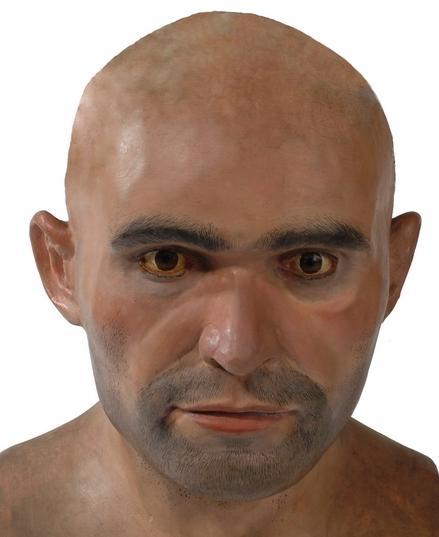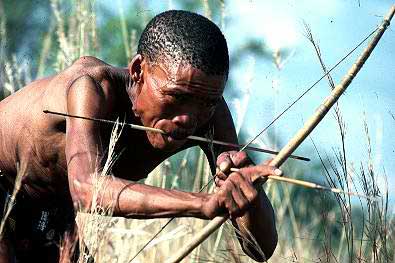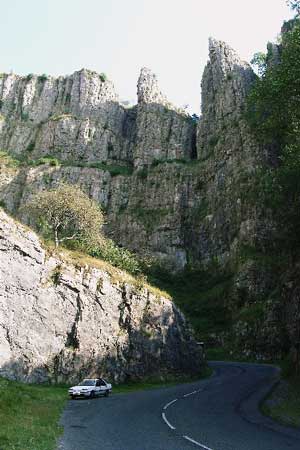
Neil Faulkner Archive | ETOL Main Page
Marxist History
Published online by Counterfire, 4 June 2010.
Copied with thanks from the Counterfire Website.
Marked up by Einde O’Callaghan for the Encyclopaedia of Trotskyism On-Line (ETOL).
In the second of his regular series Neil Faulkner reveals the incredible innovation and adaptability of our ancient ancestors, their unique combination of language and imagination and how cultures formed to fit the different environments in which early societies lived and worked.

|
Somewhere in Africa 200,000 years ago lived a woman who is the common ancestor of every human being on Earth today. We know her as ‘African Eve’. She was the first of her species: Homo sapiens – modern humans.
It is DNA analysis that has revealed this. DNA is the chemical coding within cells that provides the blueprints for organic life.
Similarities and differences can be studied to see how closely various life-forms are related.
Mutations occur and accumulate at fairly steady rates. This allows geneticists not only to measure biological diversity within and between species.
They also help estimate how much time has passed since two groups separated and ceased interbreeding.
Mutations in our DNA therefore constitute ‘fossil’ evidence of our past inside living tissue.
The DNA date for African Eve matches the date of the earliest known fossils of Homo sapiens. Two skulls and a partial skeleton found at Omo in Ethiopia in 1967 have been dated to c. 195,000 BP (before the present).
The new species looked different. Archaic humans had long, low skulls, sloping foreheads, projecting brow-ridges, and heavy jaws. The moderns had large, dome-shaped skulls, much flatter faces, and smaller jaws.
The change was mainly to do with increased brain-size: Homo sapiens was highly intelligent. Big brains make it possible to store information, think imaginatively, and communicate in complex ways. Language is the key to this
The world is classified, analysed, and discussed through words. African Eve was a non-stop talker. Because of it, in evolutionary terms, she was adaptable and dynamic.
Homo sapiens had this unique characteristic: unlike all other animals, including other hominids, she was not restricted by biology to a limited range of environments.
Thinking it through, talking it over, and working together, Homo sapiens could adapt to life almost anywhere.
Biological evolution was superseded by cultural evolution. And the pace of change accelerated. Handaxe-wielding Homo erectus had remained in Africa for 1.5 million years.
In a fraction of that time, the descendants of African Eve were on the move. Or some of them were.
|
|
The genetic evidence shows that the whole of Asia, Europe, Australia, and the Americas were populated by the descendants of a single group of hunter-gatherers who left Africa about 3,000 generations ago – around 85,000 BP.
Southern Asia and Australia were colonised by 50,000 BP, Northern Asia and Europe by 40,000 BP, and the Americas by 15,000 BP.

A modern day hunter gatherer |
Why did people move? Almost certainly, as hunter-gatherers, they went in search of food, responding to resource depletion, population pressure, and climate change. They were adapted for this – adapted to adapt.
They were designed for long-distance movement: for endurance walking and running. Their manual dexterity made them excellent tool-makers. Large brains rendered them capable of abstract thought, detailed planning, linguistic communication, and social organisation.
They formed small, tight-knit, co-operative groups. These were linked in loose but extensive networks based on kinship, exchange, and mutual support.
They were, in a literal sense, ‘cultured’: their ways of getting food, living together, sharing tasks, making tools, ornamenting themselves, burying the dead, and much else were agreed within the groups. Each group was a miniature democracy.
The dominant characteristics of Homo sapiens were cultural adaptability and planned collective labour. Wherever they went, the new humans fitted in. In the Arctic, they hunted reindeer. On the frozen plains, mammoth. On the grasslands, wild deer and horses. In the tropics, pigs, monkeys, and lizards.

Late Palaeolithic blade tool |
Toolkits varied with the challenges. Instead of simple handaxes and flakes, they manufactured a range of ‘blades’ – sharp-edged stone tools longer than they were wide that were struck from specially prepared ‘prismatic’ cores.
They also made clothes and shelters as conditions demanded. They used fire for heating, cooking, and protection. And they produced art – paintings and sculptures of the animals they hunted.
Above all, they experimented and innovated. Successes were shared and copied. Culture was not static, but changeable and cumulative. Homo sapiens met environmental challenges with new ways of doing things, and the lessons learned became part of a growing store of knowledge and know-how.
Instead of modern humans either evolving biologically or dying out when environmental conditions changed, they found solutions in better shelters, warmer clothes, or sharper tools. Nature and culture interacted, and through this interaction, humans became progressively better at making a living.
In places, for a while, Homo sapiens co-existed with archaic humans. Between c. 40,000 and 30,000 BP, Europe was inhabited by both moderns and Neanderthals. There is no evidence that they did – or could – interbreed or that they interacted in any way at all. [1]
The Neanderthals probably died out because they could neither adapt nor compete as the climate changed, as Homo sapiens populations grew and as the big game on which all hominids depended were over-hunted.
Stone-tool technology seems to shadow this species displacement. Neanderthal fossils are associated with ‘Mousterian’ flakes. Cro-Magnon fossils (as Homo sapiens remains are known in European archaeology) are associated with a range of sophisticated ‘Aurignacian’ blades.

Cheddar Gorge |
That is not all. The new culture was diverse and dynamic, producing, in the course of time, spear-throwers, the harpoon, and the bow. Dogs were domesticated and joined the hunt. The Neanderthals had been at the top of the food-chain, but the new arrivals plunged them into a ‘cultural arms-race’ they could not win.
Gough’s Cave in Somerset’s Cheddar Gorge is a classic Homo sapiens site. It has yielded human remains, animal bones, thousands of stone tools and artefacts of bone and antler.
These date to around 14,000 BP and belonged to a community of horse-hunters. The cave offered shelter and a vantage-point overlooking a gorge down which herds of wild horses and deer regularly passed.
Here was a community of Homo sapiens adapted to a very specific ecological niche: naturally funneling the migration routes of wild animals during the latter part of the last great glaciation.
The period from 2.5 million years ago, when tool-making began, to 10,000 BP is known as the ‘Old Stone Age’ or ‘Palaeolithic’.
Its last phase, the ‘Upper Palaeolithic’, is the period of Homo sapiens. It represents a revolutionary break with earlier phases.
The Upper Palaeolithic Revolution was both biological and cultural. A new species of super-hominid emerged from Africa and spread across the world.
In this first globalisation, the species adapted to diverse environments and opportunities by creating numerous distinctive ‘cultures’ – repertoires of tools, work methods, social customs, and ritual practices.
But by 10,000 BP, there was a problem. The big game were dying out. The Earth was warming and the open plains were disappearing beneath regenerated forest. And the hominids had been too successful: mammoths, giant deer, and wild horses had been hunted to extinction.
The Upper Palaeolithic world had reached an impasse. The existing mode of production could no longer ensure survival. Homo sapiens were about to face a supreme test of evolutionary fitness.
1. There is now (2022) genetic evidence of interbreeding between Neanderthals and modern humans. Some recent studies suggest that people of European and Asian origins may have 1–2% Neanderthal genes.
Neil Faulkner Archive | ETOL Main Page
Eleven Reasons to Fight
Last updated on: 13 February 2022